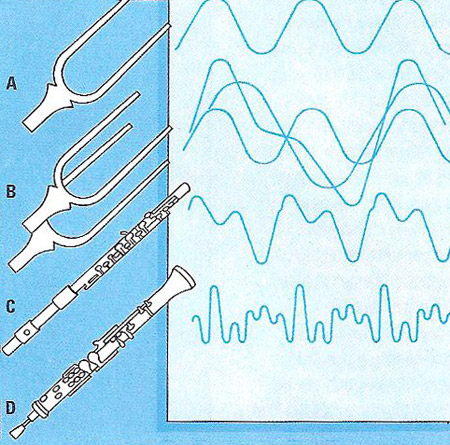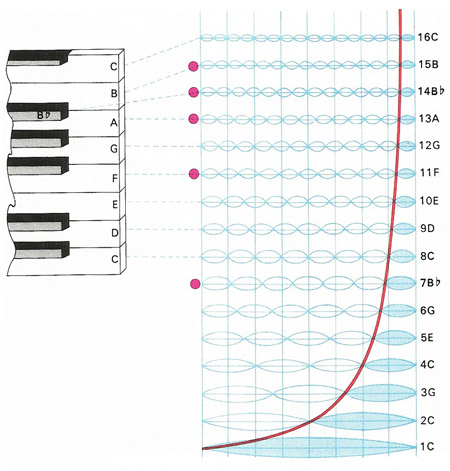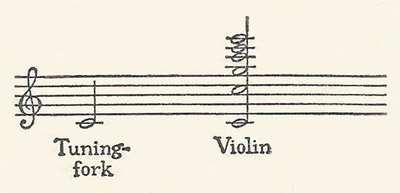harmonics

A tuning fork vibrates, producing form of a single pitch – its fundamental frequency (A). A more complex sound pattern will arise when two forks are struck together (B). The fundamental pitch of the vibrating column of air in a flute is enhanced by other shorter wavelength sounds which are multiples of the fundamental (C). Woodwind instruments have a more reedy sound because of the interaction of all these different frequencies heard together (D).

Harmonics result from simultaneous vibration of smaller and smaller divisions of a vibrating string or air column. In the first 16 harmonics five (marked with dots) are out of tune.

The tuning fork sounds practically only its own fundamental, which accounts for its colorless tone quality. When a note is played on the violin, however, many simultaneous harmonics occur, which color the tone.
Harmonics or, more precisely, harmonic partials (see partial), are frequencies in a sound that are integral multiples of the fundamental frequency. For example, the fundamental frequency of middle C is 262 Hz, but a middle C as sung or played on a musical instrument also has harmonics at 524 Hz, 786 Hz, 1,048 Hz, and so on.
All harmonics are overtones, but not all overtones are harmonics. The second harmonic is the first overtone, the third harmonic is the second overtone, and so forth. The fundamental plus the harmonics that sound at the same time make up a harmonic series.
Harmonics extend without limit beyond the audible range. They are characterized as even-order and odd-order harmonics. A second-order harmonic is two times the frequency of the fundamental; a third order is three times the fundamental; a fourth order is four times the fundamental; and so forth. Each even-order harmonic – second, fourth, sixth, etc. – is one octave or multiples of one octave higher than the fundamental; these even-order overtones are therefore musically related to the fundamental. Odd-order harmonics, on the other hand – third, fifth, seventh, and up – create a series of notes that are not related to any octave overtones and therefore may have an unpleasant sound. Audio systems that emphasize odd-order harmonics tend to have a harsh, hard quality.
Playing harmonics on various instruments
While harmonics, including the fundamental, are normally heard in combination some of them can, on some instruments, be separately obtained. For example, by blowing in the right way, a brass tube, instead of producing its first harmonic (fundamental), can be made to produces its second, third, or some other harmonic. By lightly touching a string, or a length of string (i.e., a stopped string), at its center and then plucking or bowing it, it can be made to produce its second harmonic; by doing the same at a third of its length it will, similarly, produce its third harmonic. Natural harmonics are those produced from an open string; artificial harmonics those produced from a stopped string.
At one period the only notes obtainable from a horn or trumpet were the harmonics that belonged to the fundamental note of its length of tube. Crooks and shanks were introduced which, inserted in the instrument, lengthened it and so altered its fundamental note and, hence, its whole harmonic series. (A crook is a curved piece of tube and a shank is a straight one; their functions are identical.) Whilst any particular crook or shank was in use the player was still limited to the relevant harmonic series with all its gaps: then valves were introduced, in place of the crooks or shanks, and the length of the tube could be immediately changed and rechanged, thus making it possible to change the whole harmonic series without delays and making easily and rapidly available any note whatever that was required by picking a harmonic series in which it conveniently occurred. On the woodwind, similar changes in effective length are secured by covering or uncovering side-holes in the tube by the fingers.
Many vibrating bodies, however, produce overtones which are not members of the harmonic series. The more closely these overtones are related to members of a harmonic series, the more pleasant i the combined sound to the ear. An irregular piece of metal, roughly struck, will give out a number of vibrations of unrelated frequencies, producing an unmusical sound, or noise; the same piece of metal carefully shaped and struck can give out vibrations that accord with the harmonic series of the fundamental note of the piece of metal, and will produce a musical tone.


